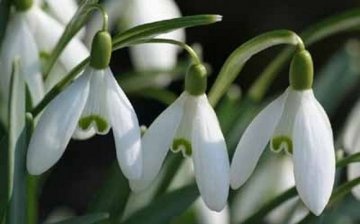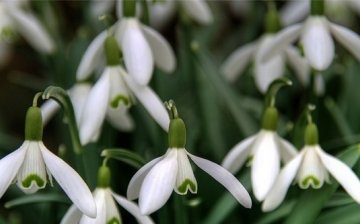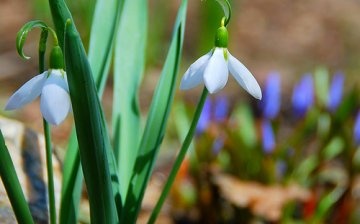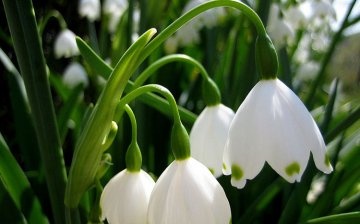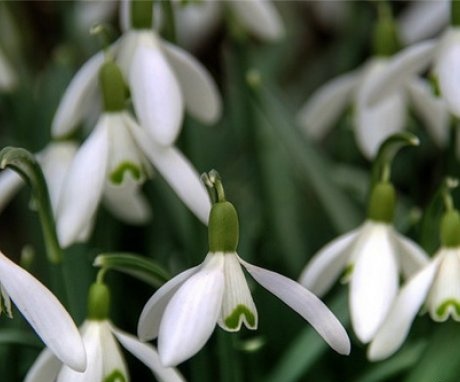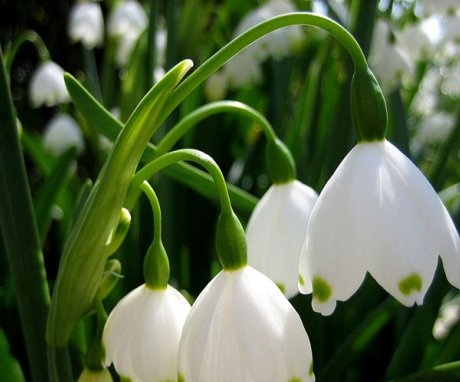When different types of snowdrops grow
Snowdrops are perennial bulbous plants of the Amaryllis family. The lowest species are 10 cm high, and the highest reach 30 cm. Each flower consists of three inner and three outer perianths of a milky white color.
Content:
First spring flowers
Snowdrops - the very first delicate and beautiful flowers. Many works have been dedicated to them for a long time, let us recall the well-known fairy tale "Twelve Months", in which a spoiled princess wished to receive snowdrops in the midst of winter and severe frosts. As a result, the evil stepmother sent the poor stepdaughter in search of spring forest flowers. Remember who helped the unfortunate girl - the young month of April. Remembering this tale, the question arises - when the snowdrops grow, is it really in the month of April?
According to an old legend, the snowdrop became a hope for Adam and Eve, who were expelled from Paradise. The angel turned snowflakes into snowdrops, which became for the first people an omen of the arrival of spring and warmth.
Types of snowdrops
In nature, there are about 18 species of snowdrops that grow all over the world.
The most common and familiar for each of us are:
- Snowdrop Snow White (Galanthus nivalis L.). The leaves are flat, dark green, up to 10 cm long. The peduncle reaches a length of 12 cm, and the flower itself is 3 cm in diameter, white with green spots at the ends of the perianths. Blooms in late March - early April. It is the most popular species in horticulture. Grows naturally in Central and Southern Europe and the Ciscaucasia;
- Snowdrop Elveza (Galanthus elwesii Hook). Tall species with a peduncle up to 25 cm. Leaves are wide, up to 2 cm, bluish-green, nested at the base of one another. The flowers are large, spherical, up to 4 cm long, have a delicate pleasant aroma. Elveza snowdrops bloom earlier than Snow White snowdrops. They grow naturally in Southeast Europe and Asia Minor. There are about 15 known varieties cultivated in Europe;
- Alpine snowdrop (Galanthus alpines). The leaves are dark green, during flowering up to 7 cm long, and after flowering reaches a length of 25 cm.The peduncle is about 9 cm, the outer petals of the flower are up to 2 cm long, and the inner petals are up to 1 cm.In nature, it is found in the alpine meadows of the western and southwestern Transcaucasia. Bloom from mid-March to mid-April;
- Voronov's snowdrop (Galanthus woronowii). The leaves are bright green with a yellowish tinge, slightly curled, 16 cm long during flowering and 22 cm after flowering. The peduncle reaches 15 cm, and the outer petals of the flowers are 2.5 cm. In nature, it grows on the Black Sea coast of the Caucasus, blooms in late February - early March;
- Folded Snowdrop (Galantus plicatus). Each plant has two bluish-green leaves, up to 30 cm high. White flowers up to 2.5 cm long, inner petals with a green border. Blooms from February to April. Grows throughout the mountainous Crimea.
Growing snowdrops in the garden
Due to the fact that snowdrops are a rare endangered species, plant breeders recommend artificially breeding snowdrops in their own gardens, in gardens and in summer cottages. For these purposes, mainly two varieties are used: the Elveza snowdrop and the Snowy snowdrop.
Snowdrops are undemanding to soil, frost-hardy, and bulbs love subzero winter temperatures. It is better to choose a place for growing snowdrops in partial shade. The duration of flowering depends on the temperature - the lower it is, the longer the flowering lasts. During the budding period, snowdrops require an abundance of moisture.
After the end of flowering, the leaves of snowdrops are not pruned - they must die off themselves.
Snowdrops do not require special care and feel great in one place for a long time. They do not tolerate transplanting well, so it must be done with a clod of earth immediately after flowering, when the leaves are still fresh. Picking and disassembling bulbs is not recommended. Snowdrops are plants that don't like to be disturbed by their bulbs. For this reason, purchased bulbs in the first year let only greens, but do not bloom. The bulbs are planted to a depth of no more than 5 cm.
In the garden, the most suitable place for snowdrops are rockeries and alpine slides. When stones appear from under the snow, and with them the first green leaves and white flowers, the garden begins to come to life from hibernation.
Snowdrops look good in groups under trees and shrubs, in addition, they shade flowers from the bright spring sun, which is the key to longer flowering. If early flowering pink or lilac grows in the garden Erika, then it will become an excellent background for snow-white snowdrops, creating a spectacular contrast. Simultaneously with the snowdrops bloom crocuses, which are also perfectly combined with white flowers, complementing each other.



